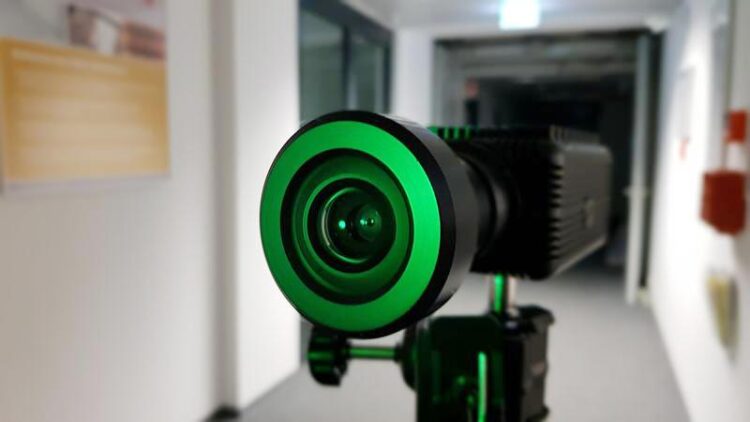Tiny package, greater depth

A gamechanger for industrial damage analytics: The plenoptic high-speed camera created by Fraunhofer IZM.
© Fraunhofer IZM
A plenoptic high-speed camera designed by Fraunhofer researchers.
Researchers at Fraunhofer IZM have joined forces with TecVenture, Optrontec Inc., and KAIST to create a high-speed camera fitted with a unique multi-lens array that can capture images with a far greater depth of field than its conventional counterparts. The miniaturized electronics make the system a good choice for efficient damage analytics in industrial use or for many research activities. To prepare the camera for reliable work in the tough reality of industrial environments without compromising its compact size, the electronics for the system were miniaturized by Fraunhofer IZM using the Institute’s embedding technology.
As production processes are accelerating everywhere in industry, manufacturers need the right means to monitor these processes at every link in the chain. Increasingly, their weapon of choice for this mission is high-speed cameras. But conventional cameras struggle with adjusting their focus quickly enough to track objects moving through their field of vision. A solution is to use cameras with a greater depth of field with the same optics, with the focus virtually adjusted by processing the resulting image data to produce a clear image at the right depth. The Fraunhofer IZM researchers and their partners took on the challenge of creating a high-speed and highly miniaturized camera capable of this feat.
The right lens is chosen for the application and the image focused on a full-format sensor. A special multi-lens or polarization filter array, made by KAIST and Korea’s Optrontec, is placed in the path between lens and sensor to get a greater depth of field and better contrast to capture even the fine structural details of the monitored objects. Operating at a speed of 2000 images per second – a tenfold increase compared to conventional cameras – the system enables an accurate visual analysis of the very fast, often critical processes happening in laboratories or factories.
The Micro-Lens Array (MLA) consists of a closely populated matrix of lenses, each placed only 150 micrometres from the next. All of the components needed to supply the image sensor are mounted directly beneath the sensor itself in a highly integrated embedded module.
With 3D stacking and different electronic components embedded directly in the circuit board, the system could not only be miniaturized into a tiny package, but also equipped with far shorter electrical connections, a must-have for better signal quality in high-speed systems of this nature. The almost completely encapsulated design also makes the system extremely rugged and robust. The highly integrated electronic module was created with the production facilities available at Fraunhofer IZM.
The camera revealed its exceptional performance immediately in the first functional trials. Over the next months, the production process will be refined and ramped up for industrial use. But the plenoptic camera is not only a great tool for industrial process analysis: Its combination of great speed and an excellent depth of field also makes it a promising choice for scientists exploring other biological, chemical, or physical processes.
Project partners:
TecVenture GmbH: https://tec-venture.de/
OPTRONTEC Inc.: https://en.optrontec.net/
KAIST Advanced Institute of Science and Technology: https://www.kaist.ac.kr/en/
Wissenschaftliche Ansprechpartner:
David Schütze l Phone +49 30 46403-670 l david.schuetze@izm.fraunhofer.de |
Fraunhofer Institute for Reliability and Microintegration IZM I Gustav-Meyer-Allee 25 | 13355 Berlin | www.izm.fraunhofer.de |
Originalpublikation:
https://www.izm.fraunhofer.de/en/news_events/tech_news/a-plenoptic-high-speed-ca…
Media Contact
All latest news from the category: Information Technology
Here you can find a summary of innovations in the fields of information and data processing and up-to-date developments on IT equipment and hardware.
This area covers topics such as IT services, IT architectures, IT management and telecommunications.
Newest articles

NASA: Mystery of life’s handedness deepens
The mystery of why life uses molecules with specific orientations has deepened with a NASA-funded discovery that RNA — a key molecule thought to have potentially held the instructions for…

What are the effects of historic lithium mining on water quality?
Study reveals low levels of common contaminants but high levels of other elements in waters associated with an abandoned lithium mine. Lithium ore and mining waste from a historic lithium…

Quantum-inspired design boosts efficiency of heat-to-electricity conversion
Rice engineers take unconventional route to improving thermophotovoltaic systems. Researchers at Rice University have found a new way to improve a key element of thermophotovoltaic (TPV) systems, which convert heat…



